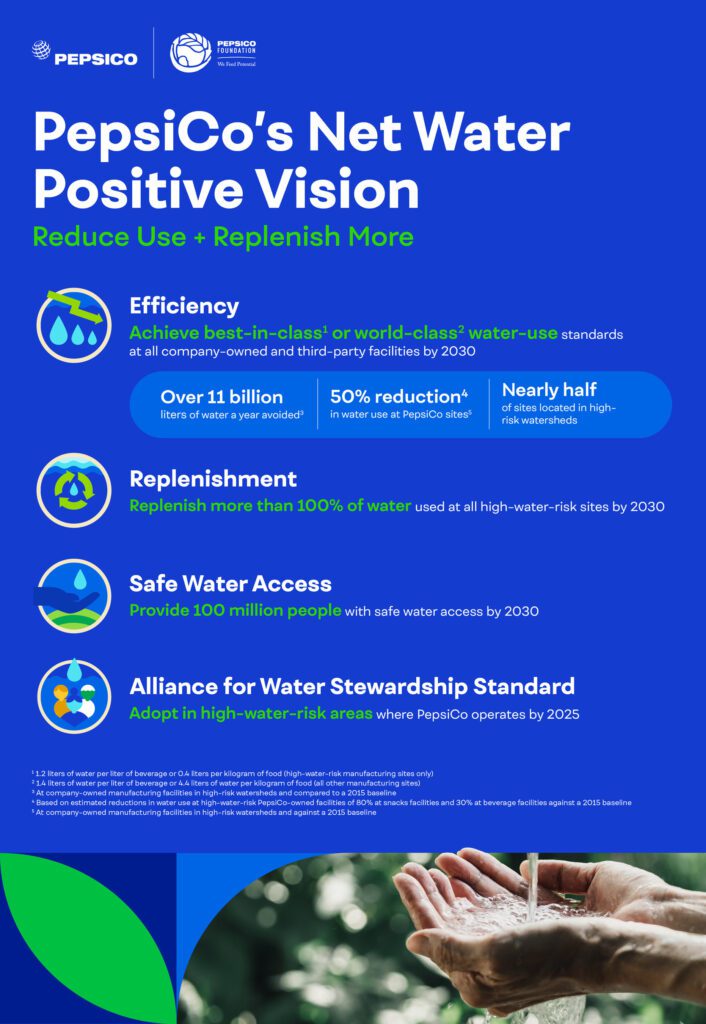PURCHASE, N.Y., U.S. — PepsiCo, Inc. has announced its ambition to become “Net Water Positive” by 2030, aiming to replenish more water than the company uses, which would place it among the most water-efficient food or beverage manufacturers operating in high-risk watersheds. With safe water access a critical component of the holistic water stewardship agenda, The PepsiCo Foundation is also launching a new $1 million program with leading NGO and long-term partner, WaterAid to bring safe water to families in Sub-Saharan Africa – expanding its 15-year, more than $53 million safe water access initiative that reaches over 20 countries and has helped more than 59 million people since 2006.
“Time is running out for the world to act on water. Water is not only a critical component of our food system, it is a fundamental human right – and the lack of safe, clean water around the world is one of the most pressing issues facing our global community today,” said Jim Andrew, Chief Sustainability Officer at PepsiCo. “Water scarcity is directly linked to the climate crisis, and at PepsiCo we believe a global effort to be ‘net water positive’ is essential. We’re focused not only on making sure people around the world have access to this vital resource, but ensuring that we are also prioritizing water stewardship in our operations everywhere.”
Bold new goals will guide tangible operational action towards PepsiCo’s “Net Water Positive” ambition to reduce absolute water use and replenish back into the local watershed more than 100% of the water used at company-owned and third-party sites in high-water-risk areas.
Reduction efficiencies are to be met through the adoption of operational best-in-class or world-class water-use-efficiency standards[1] covering more than 1,000 company-owned and third-party facilities, with nearly half located in high-risk watersheds. Raising the efficiency standard at company-owned sites in high-risk watersheds alone will allow PepsiCo to avoid using more than 11 billion liters of water a year,[2] a 50% reduction[3] in the amount of water the company uses at these sites[4]. PepsiCo also aims to adopt the Alliance for Water Stewardship Standard[5] in all high-water risk areas where it operates by 2025.

Additionally, PepsiCo’s holistic “Net Water Positive” vision looks to deliver safe water access to 100 million people by 2030.
The PepsiCo Foundation’s new investment with WaterAid is focused on Sub-Saharan Africa and will help improve water infrastructure, build new water supply systems and equitable sanitation facilities, and promote hygiene education. It will also empower women and girls to become water, sanitation and hygiene stewards in their communities by providing them with the funding and training to maintain water access points and sanitation facilities for years to come.
This new program comes at a critical time as the COVID-19 Delta variant spreads worldwide, posing a particular risk to water-stressed communities. Many nations, like those in Sub-Saharan Africa, lack the water infrastructure or supply to prevent and treat illnesses – for instance, nearly 70% of homes in the region don’t have places for families to wash their hands with soap and water. Given the importance of handwashing and sanitizing to combat the pandemic, this leaves communities highly susceptible to spikes in COVID-19. This issue is compounded given the slow pace of vaccine distribution in the region.
“We learned quickly at the onset of the pandemic that handwashing and proper hygiene were critical to slowing its spread, but for millions around the world, access to water remains a luxury. As a result, millions of lives remain in jeopardy and until we address this crisis the region will remain especially susceptible to viruses like COVID-19,” said C.D. Glin, Vice President, Global Head of Philanthropy at PepsiCo. “Not only does this disparity in water access contribute to the severity of the pandemic, but it also affects many other developmental goals of the region, including food production, gender equality, climate resilience and poverty alleviation. We’re proud of our continued partnership with WaterAid to bring this program to the region and are excited to be investing in the water-scarce areas that need this resource most.”
The investment in Sub-Saharan Africa represents an expansion of The PepsiCo Foundation’s long-term work with WaterAid, a leading international organization with over 40 years of experience bringing clean water, sanitation and hygiene to communities worldwide, including active programs in Colombia, India and Pakistan in partnership with The PepsiCo Foundation. This partnership is a cornerstone of The PepsiCo Foundation’s safe water access program, which has generated more than $10 in impact for every $1 invested since 2005 and catalyzed nearly $700 million in additional funding for safe water access investments in partnerships with non-profits worldwide.
“The PepsiCo Foundation is a stalwart partner of WaterAid across three continents,” says Kelly Parsons, CEO, WaterAid America. “They are funding critical programs, providing flexibility to respond to the pandemic, and shouting loudly and clearly about the importance of safe water access for the billions who lack it. We are proud to partner with The PepsiCo Foundation and are committed to doing all we can to support their goal of reaching 100 million people by 2030. Their aspiration helps us reach further and work harder on behalf of those in need.”
1 PepsiCo has set a “best-in-class” standard (1.2 liters of water per liter of beverage or 0.4 liters per kilogram of food) for all company owned, bottler and franchisee sites in high-risk watersheds. For all others, PepsiCo has set a new goal to achieve “world-class” water use efficiency (1.4 liters of water per liter of beverage or 4.4 liters of water per kilogram of food). These standards were set based on internal peer analysis.
2 Compared to a 2015 baseline.
3 80% reduction at snacks plants and 30% reduction at beverage facilities against a 2015 baseline.
4 Against a 2015 baseline
5 The Alliance for Water Stewardship (AWS) Standard is a proven framework for bringing together cross-functional operations, agriculture, public policy and government affairs, environmental, health and safety, and supply chain associates, helping to identify and address local watershed opportunities.















